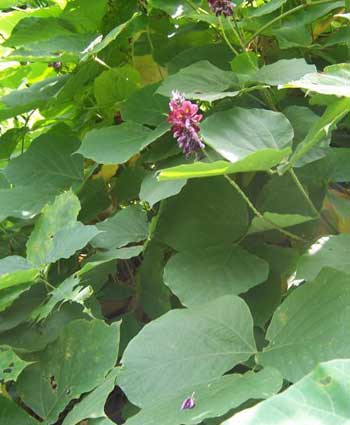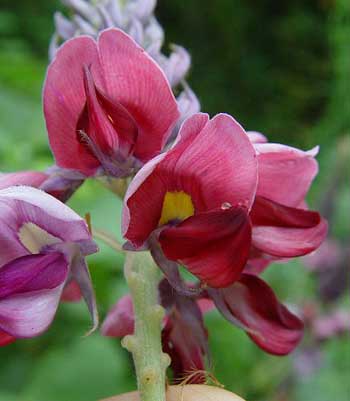Contents:
Common Names | Parts Usually Used | Plant(s) & Culture | Where Found | Medicinal Properties | Biochemical Information
Legends, Myths and Stories | Uses | Bibliography
Scientific Names

- Pueraria lobata
- Pueraria tuberosa
- Puetariae lobata et thunbergiana
- Pachyrhizus thunbergianus
- Leguminosae
- Pea family
Common Names
- Ko (Chinese name)
- Kudzu root
- Pueraria
Parts Usually Used
Root, flowers, seeds, stems, root starch
Back to Top

Description of Plant(s) and Culture
Kudzu is a noxious, robust, trailing, or climbing vine; the leaves are palmate and 3 parted. Leaflets are entire or palmately lobed. Flowers are reddish purple, grape-scented, in a loose raceme. Blooms in July to September.
Back to Top
Where Found
Found in waste ground from Pennsylvania to Florida; Texas to Kansas. Native to Asia.
Back to Top
Medicinal Properties
Antispasmodic, diaphoretic, diuretic, digestant, demulcent, tonic
Back to Top
Biochemical Information
Large amounts of starch
Back to Top
Legends, Myths and Stories
This is a pernicious, invasive weed of the Southern United States, covering trees, bushes, fences, old abandoned buildings, etc. When it covers a tree, the tree will eventually die from lack of sunlight. Perhaps it could best be controlled by harvesting it for its medicinal potential.
Kudzu is used as a substitute for arrowroot; is claimed to have aphrodisiac properties.
Back to Top
Uses
In China the root tea is used for headaches, diarrhea, dysentery, gastroenteritis, deafness, to promote measles eruptions, and induce sweating. Also used externally for stiff neck, muscular tension. Used to treat colds, flu, digestive problems, snakebites, insect bites and dog bites. Experimentally, the plant extracts lower blood sugar and lower blood pressure. The flower tea is said to expel drunkenness. Stems are poulticed for treatment of sores, swellings, wounds, boils, skin rashes, mastitis, and stem tea is used as a gargle for sore throats. Root starch is eaten as a food.
Back to Top
Bibliography
![]() Chinese Medicinal Herbs
Chinese Medicinal Herbs, compiled by Shih-Chen Li, Georgetown Press, San Francisco, California, 1973.
![]() Eastern/Central Medicinal Plants
Eastern/Central Medicinal Plants, by Steven Foster and James A. Duke., Houghton Mifflin Company, 215 Park Avenue South, New York, NY 10000
![]() Planetary Herbology
Planetary Herbology, by Michael Tierra, C.A., N.D., O.M.D., Lotus Press, PO Box 325, Twin Lakes. WI 53181., Copyright 1988, published 1992
![]() Webster’s New World Dictionary
Webster’s New World Dictionary, Third College Edition, Victoria Neufeldt, Editor in Chief, New World Dictionaries: A Division of Simon & Schuster, Inc., 15 Columbus Circle, New York, NY 10023
![]() The Yoga of Herbs: An Ayurvedic Guide to Herbal Medicine
The Yoga of Herbs: An Ayurvedic Guide to Herbal Medicine, by Dr. David Frawley & Dr. Vasant Lad, Lotus Press, Twin Lakes, Wisconsin, Second edition, 1988.
